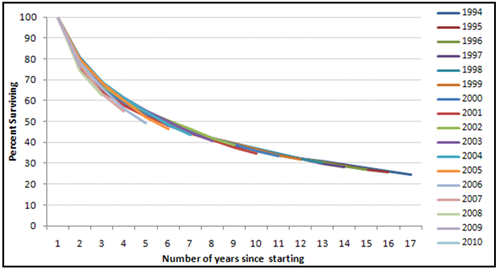
Successful Entrepreneurs Manage Your Value
3/21/2013
The current economic crisis that has engulfed most of the developed economies since 2008 has spurred much change around the world. It encouraged economists and management scholars to think differently about entrepreneurship. For instance, Nyström (2008) finds positive correlation between entrepreneurship and economic growth. However, while new companies create dynamism, most of them disappear after a short period of time. According to the US Bureau of Labor Statistics, only 56% of newly formed companies in the United States survive after five years. The logic then goes that these surviving startups will create more jobs and prompt more innovation, which will further increase economic growth. So what can be done to create more robust companies? The answer is straightforward: entrepreneurs must manage for value by adopting the Economic Value Added® (EVA) measure. EVA is particularly well adapted for startups because it helps them survive, it makes them thrive, it unlocks more funding and it is easy to understand.

Figure 1. Survival Rate of US Business Establishment (Source: US Bureau of Labor Statistics)
EVA Shapes Survivors
EVA creates more robust companies because it recognizes the importance of optimal allocation of cash. The generation of cash and its utilization (a.k.a. cash flow) are considered to be very important indicators of business health, as noted by great management author Peter Drucker. Specifically, cash flow is critical for the survival of small firms (Jarvis, et al. 2000), (Sharma 2001). A company with enough cash can never be forced out of business; or to quote venture capitalist Fred Adler: “Happiness is a positive cash flow”.
Because startups are often so cash constrained, it is critical for them to use this precious resource in the best way possible. EVA helps identify the best use of cash, i.e. the projects that will earn above the required risk-adjusted return. In other words, by carefully selecting their next move with EVA, entrepreneurs ensure that their businesses will generate more positive value than the level of risk taken. Using EVA, businesses are less likely to make ill-formed decisions that will destroy value and drain cash away.
Therefore, EVA helps startup survive by guiding them on how to optimally allocate cash. This is however only one part of the story. Successful entrepreneurs are ambitious and surviving is not enough: thriving is what counts.
EVA Defines Winners
One of the most potent aspects of EVA is that it measures both the value and the performance of a company. EVA is an absolute scale: positive for value creation and negative for value destruction. Furthermore, the change in EVA is a very powerful indicator to assess the dynamic of a firm. For an entrepreneur, running a company that shows constant EVA growth is a tremendous achievement because it means that there is an increase in value creation at the firm. Even if absolute EVA is negative (which is very often the case with startups), positive changes in EVA are a healthy sign for the company.
Unlike other measures that can be deceptive (Enron, anyone?), EVA doesn’t mislead. When managing for value, entrepreneurs also know what it takes to be the best: generating more value than the competition. Once again, the absolute nature of EVA allows for instant comparison with peers, especially after adjusting for the firm’s size. Instead of navigating at sight or with faulty instruments, entrepreneurs can rely on an ever-accurate compass to sail their company through tumultuous tides.
EVA is Investors' Friend
Another important aspect of EVA is that it makes entrepreneurs’ access to funds easier. After the first stages where most of the startup’s equity comes from the entrepreneur and his relatives, the growth of the business is synonymous with access to external funding. Investors in startups are rationale folks: they seek the best compromise between the expected return of the business and its risk profile. Because EVA is well-known and highly respected among external investors, entrepreneurs using EVA inherently signal a lower risk level for their businesses. In other words, because entrepreneurs use EVA and can show the numbers, they gain credibility and the attention of many more investors.
The discipline brought by EVA facilitates the growth of the business through easier access to money. Nevertheless, EVA must be easily understood by entrepreneurs in their startups to make a real impact.
EVA is Easy to Grasp
It is tempting to think that a management tool producing great results is difficult. After all, if it is so easy, why doesn’t everyone use it? Let us humbly argue that EVA is simple to understand. If not all entrepreneurs use it, it is because it represents a different paradigm, far from the accounting model to which most entrepreneurs have grown accustomed. EVA is easy to grasp because its core components are well known financial concepts.
Properly defining EVA requires some adjustments but in essence it comprises three simple, intuitive items: profits, taxes and cost of capital. These three basic concepts can be understood by anyone with little experience in business. You sell a product, which generates revenue. After paying your operating expenses, you must pay taxes on what you earn. And because you needed money to start the business, you either need to pay back your debt or earn as much as you could have had you chosen to do something else. This is it: no rocket science.
In fact, the EVA principles are so simple that they can be taught in a couple of hours to [CV8] entrepreneurs of all backgrounds. For instance, the Singapore-based NGO Soconomist is currently teaching value-based management (the core philosophy of EVA) to aspiring Cambodian entrepreneurs. In fact, the Soconomist team has deemed value-based management simple and concrete enough to include it in the Finance curriculum of their Entrepreneur Education Program.

Conclusion
While most of the literature concerning EVA of value-based management has concerned large corporations and established companies, our approach is extremely relevant to help entrepreneurs be successful. EVA is a powerful tool that enables startups to survive longer, provides them with the discipline to thrive and is easy to understand by entrepreneurs. They ought to try it.